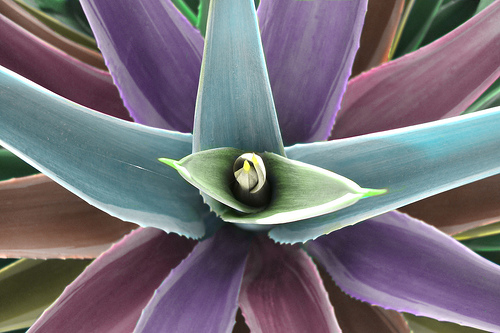 Agave: not just for tequila anymoreDear Checkout Line,
Agave: not just for tequila anymoreDear Checkout Line,
What’s the skinny on sweeteners? I use agave nectar, but I’m wondering if the same thing that makes tequila can be good for me and my six-year old! Is sucanat just another word for “sugar”? And what about Stevia? Liquid or powder, fair trade, organic — it’s all making me woozy. Or maybe that’s just my blood sugar.
Thanks for checking it out,
Sweetie
Dear Sweetie,
Your point on agave nectar is well-taken: Can the same plant that produces a drink that yields only hazy memories of crazy dancing, Miranda rights, and a Vegas wedding chapel really produce something other than a searing hangover, a court date, and an embarrassing annulment? Um, speaking hypothetically, of course it can!
Moving on: The skinny on natural sugar alternatives is that they are a big, fat business opportunity and therefore worth a closer look. You know that our species is genetically programmed to eat sweets until we pretty much explode. Savvy consumers are constantly trying to avoid not only the dizzying amount of sugar and high-fructose corn syrup in our food supply, but also spooky artificial sweeteners, most of which were discovered by accident by people wearing safety goggles and lab coats. This leaves us to appease our sweet tooth with natural sweeteners, a few of which are having a “moment.” But are they–like Ponzi schemes, unnaturally muscular athletes, and Tequila-born love affairs–just too good to be true?
Let’s take a look at those you mentioned.
Agave Nectar
What it is: Syrup made from the sap of a large, slow-growing succulent farmed in Mexico. Although the “nectar” can come from several species of agave, some of it does come from the sweetest variety, the Blue Agave, the same plant that produces tequila. It is made by taking juice from the agave’s core, then filtering it using enzymes, and heating it. Don’t worry about your nectar fermenting into tequila. “That would take about four years,” says Brian Oaks, president of Global Goods, which makes Volcanic Nectar.
Pros: Neutral taste, smooth consistency. Vegans who are opposed to honey appreciate the fact that it’s plant-derived yet does not exploit bees (and even a honey-loving bee-exploiter like me has to admit that they are working waaay too hard and need union representation). Nectar is possibly a low-glycemic food. Agave is also a slow-growing, hardy, indigenous, low-irrigation crop that is not known to be doused with pesticides. Right now there is a glut of agave (because of slumping tequila demand, not to be confusing with slumping tequila drinkers), so scaling up production to meet our cravings is not an issue, should nectar-demand soar. Even if that happens, agave unlikely to become a biodiversity-wrecking mono-crop because it takes so long to grow.
Cons: Agave nectar is not low-cal (it has about the same calories as sugar; on the other hand, it’s sweeter, so you need less). It also may not be low on the glycemic scale depending on how it’s processed. There are some concerns about the use of agave nectar by pregnant women, because some agave species contain natural steroids that could lead to miscarriage. Dr. Andrew Weil, cuddly integrative medicine icon, addresses this concern (he’s not too worried) here.
Taste: Bland, which is good news if you don’t want it to interfere with your beverage (where nectar is often used). I tried it and liked it in hot tea. It’s also good in mixed drinks (to the horror of Kentuckians, I might add it to my mint juleps this year). The darker syrups have a stronger flavor that is still subtle but vaguely similar to honey. Here’s a hilarious testament to its rising popularity: Coke’s Full Throttle “Blue Demon” energy drink boasts agave flavor.
Tip: USDA-certified organic nectar is available. Fair Trade certified nectar is not available yet, but I’m told it’s in the works. If you are concerned about the glycemic index, talk to your doctor before using it, bug the company about its process, and do your homework about glycemic labeling (sorry, not my bailiwick – remember when eating didn’t require so much work?). Oaks also suggests that you ask for the company’s “chemical analysis.” To see what this means, go here.
Stevia
What it is: A shrub native to Paraguay, now grown in many countries. The steviosides from its leaves (refined extracts) are approximately 300 times sweeter than sugar. Rebaudioside A, or Reb A, is the sweetest of the natural compounds in the plant’s leaves that are extracted to make sweeteners. The FDA granted approval (i.e., issued a “no objection letter to GRAS [generally regarded as safe] status”) for sweeteners made from Stevia extracts last year, so look for an explosion of rebbed-up products soon. Invevitably, Sprite Green, sweetened with stevia extracts, is now being test-marketed in certain cities. (Note to environmental movement: it’s officially time to get a new color theme. Fuchsia, perhaps? Burnt umber?)
Pros: No calories; doesn’t raise blood sugar. The plant’s characteristics may lend itself to sustainability. “It is a robust plant, and grows well without many chemicals,” Dorn Wenninger
Corporate VP Supply Chain for PureCircle, a Stevia supplier, told me by email. “Stevia thrives with high organic matter in the soil, and hence performs best with organic fertilizers.” He also noted that Stevia is labor-intensive in its planting, weeding, and harvesting. “Accordingly, today’s farms are very small in terms of global agriculture. Smaller plots tend to have closer management, as well as avoid some of the plant disease issues with more intensively grown crops.”
Cons: May have an aftertaste that some describe as licorice-like. At the moment it’s expensive compared to sugar. Doubts about its safety linger, largely because it is assumed that Americans will love it and consume vast quantities of it. How large-scale demand will affect the small-crop, low-spray growing style of Stevia remains to be seen, especially if the stuff is grown en masse in China. Stevia’s carbon footprint is anyone’s guess.
Taste: For the sake of experiment I recently swirled PureVia (see below) into my coffee, and it’s pretty good, but with an ever-so-faint, unidentifiable aftertaste. Mostly it just tastes sweet. Because you mentioned the liquid form of Stevia, I’ll mention that the potent drops now comes in different flavors. Triple certified skim latté with raspberry-chocolate Stevia, anyone?
Tip: Read labels: Two new pharmaceutical-sounding sweeteners, PureVia and Truvia (made by Whole Earth Sweetener Company/Pepsi and Coke/Cargill, respectively) are made from Reb A and the sweetener erythritol, which I haven’t researched (tomorrow is another day…).
Sucanat
What it is: the name is an awkward contraction of suger-cane-natural, and it’s basically unrefined sugar or dehydrated sugar cane juice. Here’s the Wiki.
Pros: It’s not as highly processed as white sugar (but if it looks like a duck and quacks like a duck . . .). It can be used as a one-for-one replacement for refined sugar. Unlike the above industries, sugar is not new, so its problems are well-known.
Cons: Although less refined, it’s still sugar, with all of its inherent problems (it offers only empty calories, it’s problematic for people with certain health problems such as diabetics, it causes dental mayhem, is generally irresistible to anyone less than four feet tall and to many of us–ahem–who are, oh, about five-foot-four). Sugar, btw, as a crop is environmentally hellish–very hard on biodiversity and ecosystems. Read about it in this World Wildlife Fund report (PDF), if you want to feel really bad about baking cupcakes for your six-year old.
Taste: It has a mild molasses flavor. To me it tastes like dry brown sugar.
Tip: Buy organic and Fair Trade certified sucanat. Before using it for your next batch of muffins, heed this advice: “It gives baked goods a caramel undertone much like brown sugar so keep that in mind when baking with it,” advises Grist’s baking babe, April McGreger. “For example, it might dull the taste —and color—of something bright and fruity like lemon curd or strawberry jam, but would be wonderful with oatmeal cookies, banana bread, and anything with nut, chocolate or coffee flavors.”
Well, Sweetie, after all that, you’ll be bewildered to know that sugar, like those oversized, insectoid sunglasses that were hideous the first time around, is back in style. If you have questions about sweeteners and your blood sugar (which you mentioned), ask your doctor. If you have questions about a product, don’t hesitate to contact the company through their web site or by phone.
I do realize that there are other natural sweeteners on the market that I don’t have time to cover (McGreger told me that she loves sorghum molasses, as does my sweet-toothed daughter), but I’m getting pretty jittery myself from all this sweetener testing.
In the meantime, stay away from those pitchers of Patrón Margaritas. I’m just saying.
Lou


